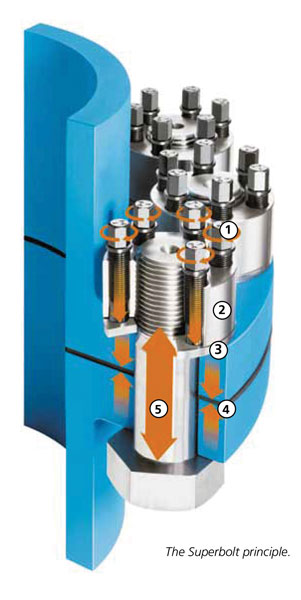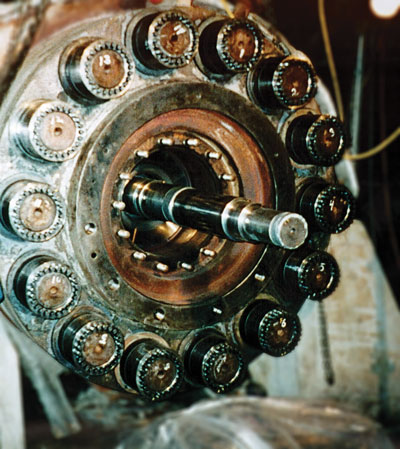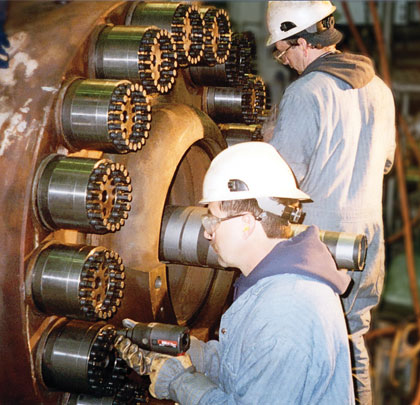Superbolt makes easy work for boiler feed pump workers
Nuts and bolts are one of the most basic and commonplace components in any piece of assembled equipment. At larger diameters, they can also be one of the most challenging. Part of the problem is that while the strength of a screw fastener increases with the square of its diameter, the torque required increases by the third power. That means, with larger diameters, achieving proper preload levels typically requires some form of high energy equipment.
A NEW WAY NEEDED
For this boiler feed pump (see figure 1), the 5-inch (127 millimeter) studs were previously tightened with a very large wrench in conjunction with heating rods. This method required 1-2 shifts (sometimes three) with three workers for installation or removal. Occasionally a nut would seize and would require destructive removal.
Three workers were required because it took two to manipulate the tool and one to operate the overhead crane. Excessive bolting time during an unscheduled pump repair can cost the utility hundreds of thousands of dollars in lost generation. For these types of applications, making this job safer and faster is highly beneficial to both the workers and the utility.
THE SOLUTION
The ideal bolting method would be one that allowed you to achieve accurate tension, safely, and quickly—without the use of any special tooling. One solution that meets these criteria and offers a purely mechanical approach to tightening is the Superbolt multi-jackbolt tensioner (MJT). This technology utilizes a number of smaller jackbolts threaded through the tensioner body to achieve preload, rather than turning one large nut or bolt. The result is that this tensioner can be installed or removed using a hand-held electric or air-powered torque wrench.

A CLOSER LOOK
A Superbolt tensioner is comprised of three components—a hardened washer, a tensioner nut body, and jackbolts. To install (see figure 2) the hardened washer (3) is installed first to protect the joint surface. Then the tensioner body (2) is spun on hand tight, for positioning. The jackbolts (1) “push” the nut body up, tightening the existing bolt or stud in pure tension (5).
For this particular boiler feed pump, MJTs were installed using ½-inch (12.7 millimeter) impacts for initial tightening, and calibrated torque wrenches for the final torquing step. Two workers were utilized for the installation which required about fifteen minutes to spin the tensioners into position, and one hour and twenty-one minutes to tighten. This was a significant time savings versus the previous method.

PROVEN TECHNOLOGY
Multi-jackbolt tensioners have been around for quite a while. Boiler feed pumps are a particularly ideal application, and many plants have used these tensioners with excellent results. Another such example is for a boiler feed pump with 6-inch (152.4 millimeter) studs (see figure 3). This plant experienced similar problems with the previously time consuming and unsafe bolting method. The MJTs were installed in two hours and this proved most fortuitous as one pump repair had to be assembled and disassembled three times due to a rotor setup problem. It was estimated that the plant saved as much as 220 man hours by using the MJTs.
■ ■ ■
ABOUT THE AUTHOR
Steve Buslacchi is the global product manager for Nord-Lock’s Superbolt Division. For more information, visit www.nord-lock.com. Additional information on Superbolt tensioners can be found at www.superbolt.com.
MODERN PUMPING TODAY, June 2014
Did you enjoy this article?
Subscribe to the FREE Digital Edition of Modern Pumping Today Magazine!



